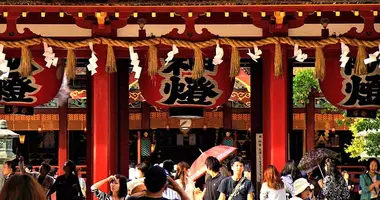Nanzoin Temple Fukuoka: Discover the world's largest bronze reclining Buddha statue
- Published on : 01/04/2024
- by : Japan Experience
- Youtube

Nanzoin Temple, Sasaguri, Fukuoka Prefecture
Nestled in the serene mountains of Sasaguri, Fukuoka Prefecture, Nanzoin Temple is a hidden gem that attracts visitors with its colossal reclining Buddha statue, the largest bronze statue of its kind in the world. This impressive temple complex, part of the Sasaguri 88 temple pilgrimage, offers a unique blend of spiritual atmosphere, stunning natural surroundings, and remarkable Buddhist art.
Belonging to the Shingon sect of Japanese Buddhism, Nanzoin Temple's main highlight is undoubtedly the 41-meter long and 11-meter high bronze reclining Buddha, weighing an astounding 300 tons. Visitors come from far and wide to marvel at this awe-inspiring statue, appreciate the temple's tranquil ambiance, and explore the picturesque natural surroundings.
History and background of Nanzoin Temple
Nanzoin Temple was originally located on Mount Koya in Wakayama Prefecture, the headquarters of Shingon Buddhism. In 1899, due to threats of destruction by anti-Buddhist authorities, the temple was relocated to its current site in Sasaguri under the leadership of priest Hayashi Satoshiun.
Over the years, Nanzoin has grown into a large complex with numerous chapels, shrines, and statues scattered across the hillside. The temple has also been actively involved in sending aid and medical supplies to children in Myanmar and Nepal, fostering international Buddhist connections.
The colossal reclining Buddha statue and its significance
Completed in 1995, the giant bronze reclining Buddha statue, known as Nehanzo or Shaka Nehan, depicts the historical Buddha at the moment of his death and entry into nirvana. The statue's impressive dimensions and intricate details make it a sight to behold, attracting visitors from all over the world.
The statue was constructed to house the ashes of the Buddha and two of his disciples, Ananda and Maudgalyayana, which were gifted to Nanzoin by the Myanmar Buddhist Council as a token of gratitude for the temple's long-standing support. The reclining posture symbolizes the Buddha's peaceful passing and his message of spiritual liberation.

Nanzoin Reclining Buddha, Fukuoka, Japan
Other notable features of Nanzoin Temple
In addition to the reclining Buddha, Nanzoin boasts several other impressive structures and statues:
- A large statue of Fudo Myo-o (Acalanatha), a fierce Buddhist deity believed to protect practitioners
- 500 statues of the Buddha's disciples (arhat), each with unique expressions and postures
- An Inari Shrine dedicated to the Shinto god of rice, prosperity, and foxes
- A shrine honoring the Shichifukujin, the seven lucky gods of Japan
The Sasaguri 88 temple pilgrimage and Nanzoin's role
Nanzoin Temple is a key stop on the Sasaguri 88 temple pilgrimage, a 44-kilometer route that takes around three days to complete on foot. Modeled after the famous 88 temple pilgrimage of Shikoku, this smaller-scale pilgrimage attracts numerous visitors annually.
As temple number 1 on the route, Nanzoin serves as a starting point for many pilgrims. The pilgrimage has connections to the revered Buddhist monk Kobo Daishi (Kukai), who spent time on nearby Mount Wakasugi, where about half of the pilgrimage sites are located.

Nanzoin Temple grounds in Fukuoka Prefecture
Visiting Nanzoin Temple: access, hours, fees and etiquette tips
Nanzoin Temple is easily accessible by train from Hakata Station in Fukuoka. Take the JR Sasaguri Line to Kido Nanzoin-mae Station (a 21-minute ride on the express train or 24 minutes on the local train), from which the temple is a mere 3-minute walk.
The temple is open year-round from 9 am to 5 pm, with free admission. However, there is a 500 yen charge to enter the prayer room underneath the reclining Buddha statue. When visiting, be mindful of temple etiquette: dress modestly, remove shoes when entering buildings, and maintain a respectful demeanor.
Appreciating the reclining Buddha statue: viewpoints, symbolism, interacting with the statue
To fully appreciate the grandeur of the reclining Buddha, take time to view it from various angles. The statue's face, with its serene expression, is best observed from a distance on clear days. Visitors can also walk around the statue to admire the intricately designed soles of the Buddha's feet, which bear significant symbolism in Buddhist art.
Engage with the statue by holding the colorful cords attached to the Buddha's hand, which represent the five colors of light seen by the Buddha during his enlightenment. Doing so is believed to grant worshippers a spiritual connection and bestow blessings from the Buddha himself.

Nanzoin Reclining Buddha, Sasaguri, Fukuoka Prefecture

Nanzoin Buddha in Sasaguri in Kyushu could be the world's biggest bronze statue
Experiencing Nanzoin's spiritual atmosphere and natural beauty in different seasons
Nanzoin Temple offers a unique experience in every season. In spring, cherry blossoms add a pop of color to the already picturesque setting. Summer brings lush greenery and a welcome respite from the heat within the temple's cool halls. Autumn sees the hillsides burst into vibrant hues of red, orange, and yellow, creating a stunning backdrop for the reclining Buddha. Winter blankets the area in a serene layer of snow, emphasizing the tranquility of the temple grounds.
No matter the time of year, Nanzoin Temple provides visitors with a chance to immerse themselves in a spiritual atmosphere, appreciate the awe-inspiring reclining Buddha statue, and find peace in the temple's natural surroundings. A visit to this remarkable site is sure to leave a lasting impression on all who make the journey.
For more information on exploring Japan's rich Buddhist heritage, consider picking up one of the many insightful books on Japan or delving into the fascinating world of Japanese temples and shrines.













